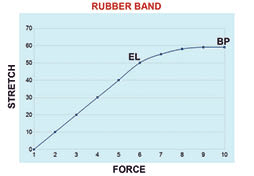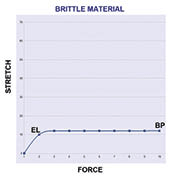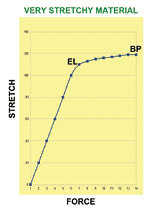

We take for granted as we move and use our hands and feet in our daily activities that nothing is going to break. Unlike our bodies there are many man-made things that do break. The design of materials so that they will stretch if we need them to, or so they will not stretch when you do not want them to is a part of engineering and physics.
 In a basic physics class we do an interesting lab exercise in which we put a rubber band on a holder and add weights to it making it stretch. We measure the amount of stretch and make a graph plotting the weight added against the amount of stretch, and for a typical rubber band the graph will look like this.
In a basic physics class we do an interesting lab exercise in which we put a rubber band on a holder and add weights to it making it stretch. We measure the amount of stretch and make a graph plotting the weight added against the amount of stretch, and for a typical rubber band the graph will look like this.
What is interesting is that there is a point where the rubber band’s stretching slows down and the rubber band stops stretching. This is called the elastic limit and is identified by EL on the graph. If the weights are taken off after reaching this point, the rubber band will be longer than it was before. When there is no stretching at all, the rubber band breaks, and that point is called the breaking point (BP on the graph).
 Every material has a different graph. The next graph shows a brittle material which would stretch so little you might not even notice and eventually it would reach its breaking point.
Every material has a different graph. The next graph shows a brittle material which would stretch so little you might not even notice and eventually it would reach its breaking point.
 The third graph shows a very stretchy material like a nylon stocking. It can also be easily stretched beyond its elastic limit producing a “run” in the stocking. The uses of this in industrial applications are numerous, and new materials that have amazing properties have been designed using this graph as a guide. In sports medicine there are numerous applications to muscles, ligaments, and tendons.
The third graph shows a very stretchy material like a nylon stocking. It can also be easily stretched beyond its elastic limit producing a “run” in the stocking. The uses of this in industrial applications are numerous, and new materials that have amazing properties have been designed using this graph as a guide. In sports medicine there are numerous applications to muscles, ligaments, and tendons.
Think of how this is applied to the design of your body. You do not want your teeth and bones to be elastic, but to be more like the second graph. The skin on the soles of your feet has to have a different graph than the skin on your knuckles. The cornea of your eye has to be still different than other materials. Your internal organs like your heart have to be designed to function and yet have the elasticity to endure many changes.
Much of what we have learned about materials science has come from studying the materials in our own bodies. Spider webs have been another area where we have seen incredible materials produced for a variety of different applications. In Psalm 139:14 David praises God saying, “I am fearfully and wonderfully made. Marvelous are your works.” Today we know that the design of the materials used in all of the creation is done with careful planning and intelligence.
Picture credits:
Charts by Roland Earnst
